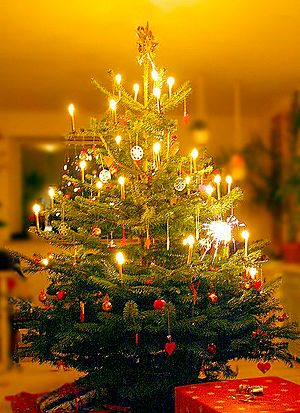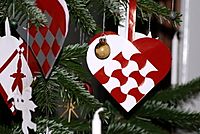Yule and Christmas in Denmark facts for kids
Jul (pronounced "yool") is the Danish word for both Yule and Christmas. It's a special time celebrated throughout December in Denmark. The festivities usually begin either at the start of Advent or on December 1st, with many fun traditions. The most important part of Jul is Christmas Eve, called Juleaften, which happens on the evening of December 24th. This is the day before the two main Christmas holidays on December 25th and 26th. In Denmark, many holidays are celebrated on the evening before the actual day.
Jul originally comes from an old Norse tradition, similar to the Yule celebrations in Northern Europe. When Denmark became Christian around the 11th century, these ancient traditions blended with the Christian celebration of Christmas. Over hundreds of years, the traditions of Jul have changed and grown, but many old customs from pagan times are still part of the celebrations today. In the 1800s, the idea of bringing a Christmas tree into homes became popular, inspired by Germany.
Contents
Christmas Eve Dinner
On Christmas Eve, families gather for a big, delicious dinner. People usually eat roast pork, roast duck, or sometimes roast goose. These meats are served with potatoes, sweet caramelized potatoes, red cabbage, and lots of rich brown gravy.
For dessert, a cold rice pudding called risalamande is served. It comes with a warm cherry sauce. A fun tradition is to hide a whole almond inside the pudding. The person who finds the almond gets a small gift, which is often a marzipan pig. In some families, this special rice pudding is made from leftover rice porridge from the night before, December 23rd, known as Lillejuleaften (Little Yule Eve). This porridge is eaten warm with cinnamon, brown sugar, and butter, often with a fruit drink.
After Dinner Fun
After the meal, families often dance around the Juletræ and sing Christmas songs. Popular songs include "Nu er det jul igen" (Now it is Yule again) and "Et barn er født i Bethlehem" (A child has been born in Bethlehem). Once the singing is done, presents from under the tree are given out. Children often help hand them out. After opening gifts, there are more snacks, candy, and sometimes a warm, spiced drink called Gløgg.
Church Visits
Many people in Denmark have a tradition of going to church on the afternoon of Christmas Eve, December 24th. The Bible story read is usually from Luke 2. Even though December 24th isn't an official holiday, going to church on this day has become very popular.
Most churches also have Christmas services on the official holidays, December 25th and 26th. The services on December 24th are the most attended of the whole year, with about one-third of the population going.
Christmas Lunches
Throughout the Christmas season, many special Christmas dinners or lunches are held. Before December 24th, many workplaces, schools, sports teams, or groups of friends organize a Julefrokost (Yule Lunch). These often happen on a Friday or Saturday evening.
After December 24th, usually on Christmas Day and the Second Day of Christmas (which are public holidays), extended families have a familiejulefrokost (Family Yule Lunch). These often involve even more food and last from noon until evening. On average, a Dane might attend three to four julefrokoster and one or two familiejulefrokoster during the Christmas period.
Typical Yule Lunch Foods
A typical Yule Lunch starts with various seafood dishes. These include open-faced sandwiches with pickled herring, shrimp, and fried fish fillets with Danish remoulade. Sometimes, cured salmon or smoked eel are also served. Pickled herring comes in many kinds, like white, red, curried, and fried. It's always served on rugbrød, a special Danish rye bread made with sourdough and whole grains.
Next, a variety of warm and cold meats are offered. These might include fried sausages, meatballs, boiled ham, liver pâté, and fried pork, served with red or green braised cabbage. Desserts are usually cheeses, fruits like oranges, clementines, and mandarins, and the special Christmas rice dessert, risalamande. People often make toasts by saying "Skål," and everyone stops eating to take a drink. To stay safe, most people use public transportation to these events.
Christmas Sweets and Treats
Throughout December, many special Christmas sweets, fruits, cakes, and drinks are available everywhere. You can find them in shops, cafés, or at home. These include:
- Nuts like hazelnut, walnut, and almond.
- Dried fruits such as apricots, figs, and raisins.
- Fresh fruits like oranges, clementines, and mandarins.
- brændte mandler (sugar-glazed almonds).
- Glazed apples on a stick.
- Pancakes.
- æbleskiver (small, round pancakes).
- pebernødder (small, spicy cookies).
- klejner (fried pastries).
- brunkager and other types of småkager (Danish cookies).
- Gløgg (mulled wine) with different recipes.
- Various marzipan treats, some with chocolate and Danish nougat.
Christmas Calendars
Denmark has adopted and expanded the German tradition of Advent calendars. It's common to have Julekalender (Yule calendars) that mark every day from December 1st to 24th. These are often made of cardboard with pictures or small treats like chocolate. They can be homemade or bought and might contain simple Christmas stories or even scratchcards.
A popular type is the gavekalender (gift calendar). These can either be a julekalender with a small gift for each of the 24 days leading up to Christmas Eve, or they can be Advent calendars with a gift for each of the four Sundays of Advent.
A unique Danish calendar tradition started by DR in 1962. They began broadcasting TV shows with exactly 24 episodes, one for each day until Christmas Eve. This tradition has become very popular, and now every major TV network has TV calendars during the Christmas period. Other Scandinavian countries have also adopted this fun tradition.
Christmas Vacation
Because there are so many holidays at the end of December, it's common for people to have a vacation between Christmas and New Year's Day without missing too many workdays. This holiday period is usually called "Juleferie" or Yule Vacation. It typically runs from December 24th until around January 1st.
Other Traditions
In Denmark, Santa Claus is known as Julemanden (which means "the Yule Man"). People say he arrives on a sleigh pulled by reindeer, bringing presents for children. He gets help with his Christmas tasks from elves called julenisser (or simply nisser). These nisser are traditionally believed to live in attics, barns, or similar places. In some traditions, children leave out saucers of milk, rice pudding, or other treats for the nisser on the afternoon of December 24th. They are delighted to find the food gone on Christmas morning, believing the nisser enjoyed it.
Danish homes are decorated with kravlenisser (climbing nisse). These are cardboard cutouts of nisser that can be attached to paintings and bookshelves. This is a unique Danish tradition that started in the early 1900s.
Julehjerter or pleated Yule hearts are handmade decorations hung on the Christmas tree. Children and other family members often make these hearts from shiny paper in different colors.
St. Lucia Day is also celebrated on December 13th.
History of Danish Christmas
Until 1770, the Christmas holidays in Denmark included the 2nd day of Christmas and Epiphany on January 6th (celebrated on the evening of January 5th). After that, only the 1st and 2nd Christmas Days remained official holidays. January 6th is now a day of celebration but not a public holiday.
The first Christmas tree in Copenhagen was lit in Ny Kongensgade in 1811. Christmas trees became popular among middle-class families around 1820 and then spread to all parts of society.





